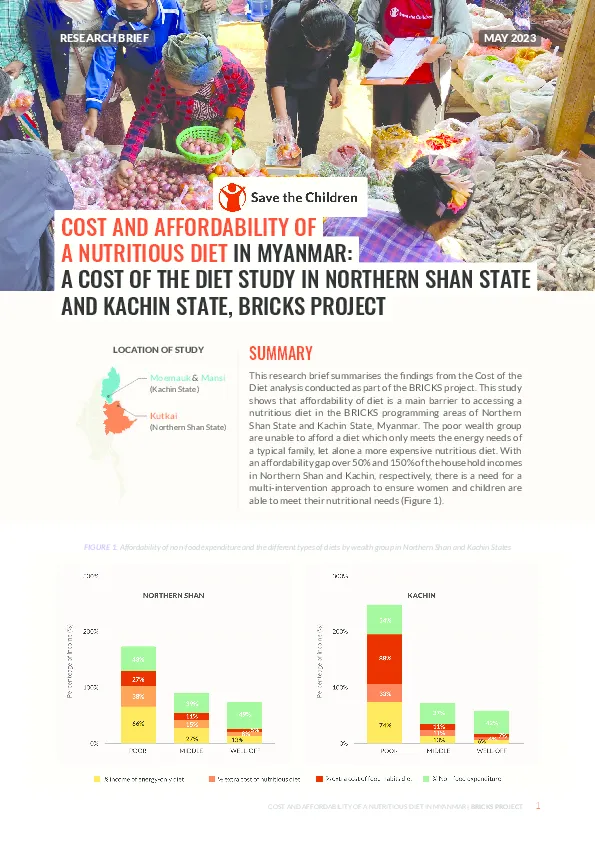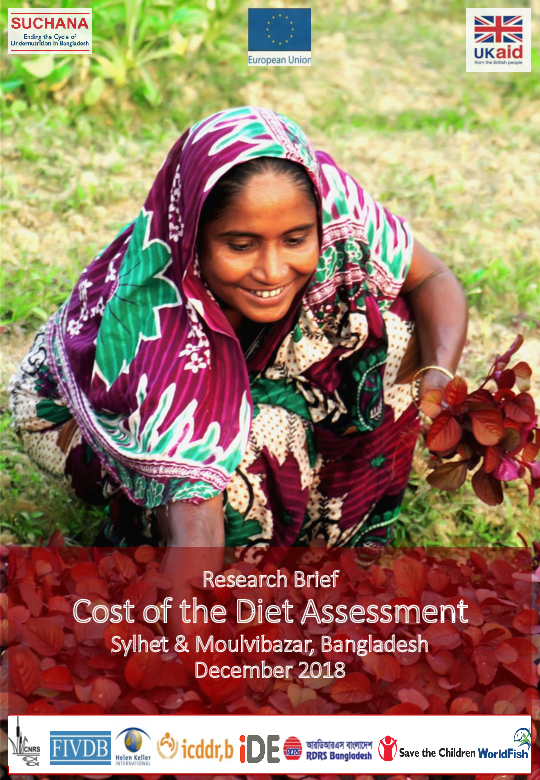Cost of the Diet
Share:
The Cost of the Diet (CotD) is an innovative method and software developed by Save the Children UK to estimate the amount and combination of locally available foods that are needed to provide a typical family or individual with a diet that meets their average needs for energy and their recommended intakes of protein, fat and micronutrients. The method was developed as a response to research undertaken by Save the Children which demonstrated that the impact of traditional nutrition education programmes has been limited because of the economic constraints facing many households in low-income countries. The tool aims to answer the following questions: 1. What is the minimum cost of foods that meet the nutrient needs of a typical household? 2. Can a nutritious diet be achieved by people using locally available foods? 3. Is this diet affordable? 4. If not, what could be done?
Photo: Sri Budiatmi shops with her daughter in Sulawesi, Indonesia

CotD Process
A Cost of the Diet assessment follows a logical process from identifying the food security and nutrition problem, collecting and analysing data, through to report writing, including recommendations and conclusions.
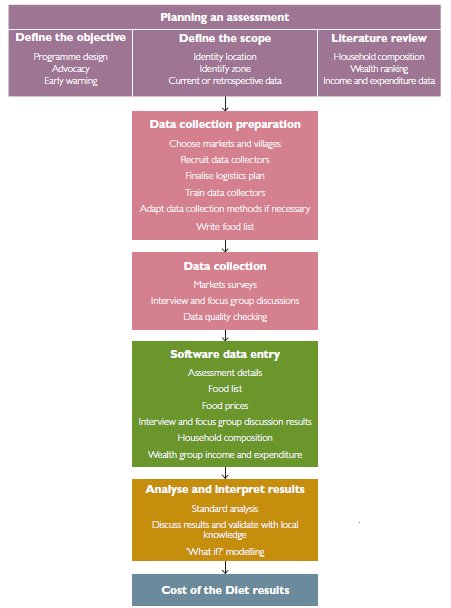 |
This figure gives an overview of the tasks and information required for a Cost of the Diet assessment.The Cost of the Diet Practitioner’s Guide explains each of these steps in more detail. The timeframe for a Cost of the Diet assessment will depend upon the length of data collection. Use the following timeframe as a rough guide:
|
Cost of the Diet Software
Cost of the Diet software uses the collected data to generate hypothetical diets using a combination of foods that will enable a family to meet their energy and nutrient requirements, as recommended by the World Health Organisation and the Food and Agriculture Organisation, at the lowest possible cost.
Limitations, or constraints, may be used to reflect typical household food consumption patterns. For example, specifying that a particular food is eaten three times a day, every day. In this way, the software can identify a diet that is more realistic in terms of the frequency with which foods are eaten.
Hypothetical Diets
The software can estimate the cost of four hypothetical diets:
1. Energy-only diet: Meets specified needs for energy only
2. Macronutrient diet: Meets specified needs for energy, fat and protein only
3. Nutritious diet: Meets specified needs for all nutrients at lowest cost
4. Food habits, nutritious diet: Meets specified needs for all nutrients at lowest cost using typically consumed local foods
Individual or Household Output
The software produces the following outputs for each of the four diets. For an individual or household:
- Average daily cost of the diet
- Average monthly cost of the diet
- Daily cost of the diet by season
- Percentage of nutrient specifications met by the diets, by season
- Annual cost of the diet
- Annual diet summary
- Affordability of diets by wealth group, if HEA data available (or other income source)
- Cost of the food groups by week (food habits diet only)
- Seasonal cost fluctuations (food habits diet only)
Food Output
The software produces the following outputs for each of the four diets. For each food selected by the software:
- Total daily weight (g)
- Total weekly weight (g)
- Edible daily weight (g)
- Edible weekly weight (g)
- Cost of the edible daily weight
- Cost of the edible weekly amount
- Daily number of servings
- Weekly number of servings
- Daily amount of each nutrient provided by the edible portion
- Weekly quantity of each nutrient provided by the edible portion
- Percentage (%) of each nutrient target provided a day by the edible portion
- Percentage (%) of each nutrient target provided a week by the edible portion
Software capabilities
Cost of the Diet software can:
- Estimate minimum cost of a locally specified diet for a range of household types
- Take into account seasonal variation in prices
- Identify the least expensive sources of energy and all nutrients
- Identify nutrients for which it may be hard to meet requirements
- Identify the foods that contribute the most to the cost of the diet
- Estimate the cost of the diet for typical families (between 5-10 members), aligned with income data generated from HEA, to estimate the affordability
- Estimate the impact on the diet or its cost of potential interventions that might help households meet their needs for energy and nutrients
‘What if’ Models
‘What if?’ models may be generated in Cost of the Diet, for specific individuals or households as a whole, to determine the potential effect of:
- New or existing nutrition interventions
- New or existing food security interventions
- New or existing social protection interventions
- Changing the nutrient specifications
- Sudden shocks
- Current infant and young child feeding practices
… on the cost, quality, composition and affordability of a nutritious diet.
Cost of the Diet examples:
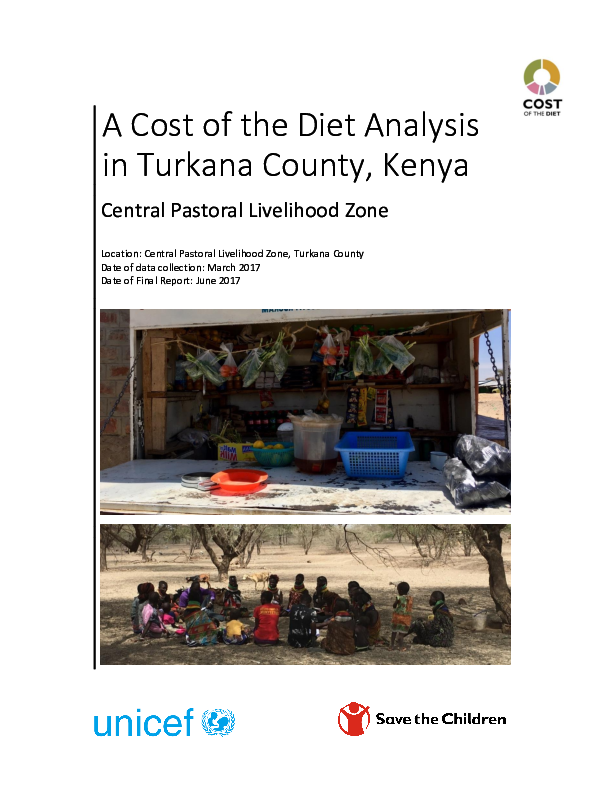
A Cost of the Diet Analysis in Turkana County, Kenya
2017 · Save the Children
Situated in the North-West of Kenya, Turkana is one of the poorest regions of the country and affected by persistently high rates of malnutrition. Persistently high rates of... View Full Abstract
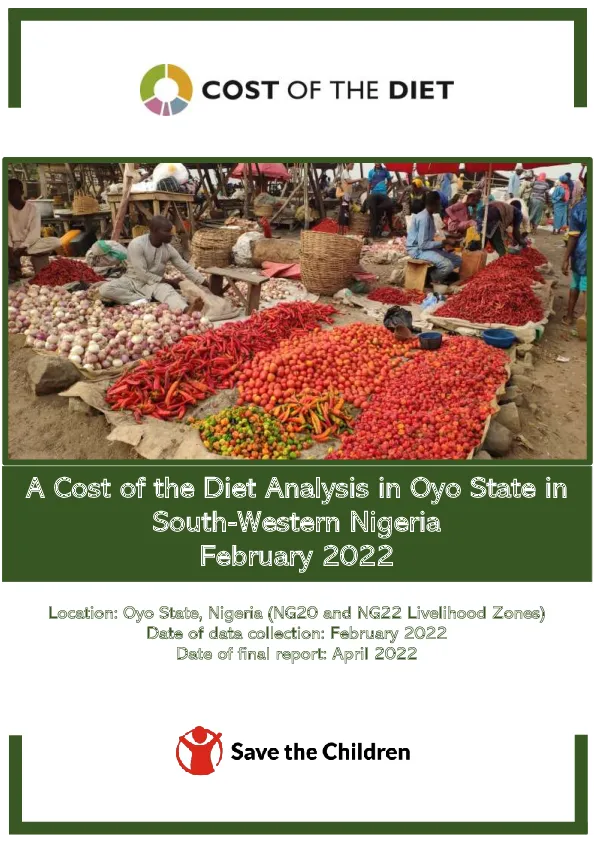
A Cost of the Diet Analysis in Oyo State in South-Western Nigeria
2022 · Save the Children International
Situated in the southwestern region of Nigeria, Oyo state has the highest prevalence (34.5 percent) of stunting among children under five; and two out of three children have... View Full Abstract
The Cost of the Diet analysis software and the guidelines are free to use. However, we do request that whenever you use Cost of the Diet analysis in reports/publications, you reference the method in the following way:
“Analysis was done using Save the Children UK’s Cost of the Diet method”.
We are keen to explore the ways that the Cost of the Diet can be used as part of programming, research and advocacy. If you have any suggestions. feedback or would like a copy of the software, please contact the Hunger Reduction and Livelihoods team at Save the Children UK at: cotd@savethechildren.org.uk
Cost of the Diet examples
4 resources
Cost of the Diet Software Guidelines
This guide aims to provide a Cost of the Diet practitioner with the information required to run a full Cost of the Diet assessment.
These guidelines and the Cost of the Diet software are free to use and can be downloaded here.
A French version of this guide and the Cost of the Diet reporting guidelines are available on request by contacting cotd@savethechildren.org.uk.
Share
Link


